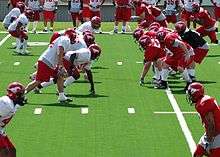Line of scrimmage

In American and Canadian football, a line of scrimmage is an imaginary transverse line (across the width of the football field) beyond which a team cannot cross until the next play has begun. Its location is based on the spot where the ball is placed after the end of the most recent play and following the assessment of any penalty yards.
A line of scrimmage is parallel to the goal lines and touches one edge of the ball where it sits on the ground prior to the snap. Under NFL, NCAA, and NFHS rules, there are two lines of scrimmage at the outset of each play: one that restricts the offense and one that restricts the defense. The area between the two lines (representing the length of the ball as extended to both sidelines) is called the neutral zone. Only the center, the offensive player who snaps the ball, is allowed to have any part of his body in the neutral zone. In order for there to be a legal beginning of a play, a certain number of the players on the offensive team, including certain eligible receivers, must be at, on or within a few inches of their line of scrimmage.
In Canadian football, the team on defense must line up no nearer than a yard to the line of scrimmage. In American football, they must only be beyond the line.
Many fans and commentators refer colloquially to the entire neutral zone as the "line of scrimmage," although this is technically not correct. Others use the general term to refer specifically to the defensive line of scrimmage, since it is the line relevant to the measurement of progress toward the goal. Referees, when explaining a penalty, will refer to "the previous spot" instead of the "line of scrimmage" in order to avoid confusion.
Modern video techniques[1] enable broadcasts of American football to display a visible line on the screen representing the line of scrimmage. The line is tapered according to camera angle and gets occluded by players and other objects as if the line were painted on the field. The line may represent the line of scrimmage or the minimum distance that the ball must be moved for the offensive team to achieve a first down.
The line of scrimmage first came into use in 1880. Developed by Walter Camp (who introduced many innovations that are part of the modern game of American football), it replaced a contested scrimmage that had descended from the game's rugby roots. This uncontested line of scrimmage would set into motion many more rules that lead to the formation of the modern form of American football.
See also
- Scrummage
- Glossary of American football
- Walter Camp, formal creator of the line of scrimmage in 1880
- Comparison of Canadian and American football
Footnotes
- ↑ Sportvision 1st & Ten graphics system.